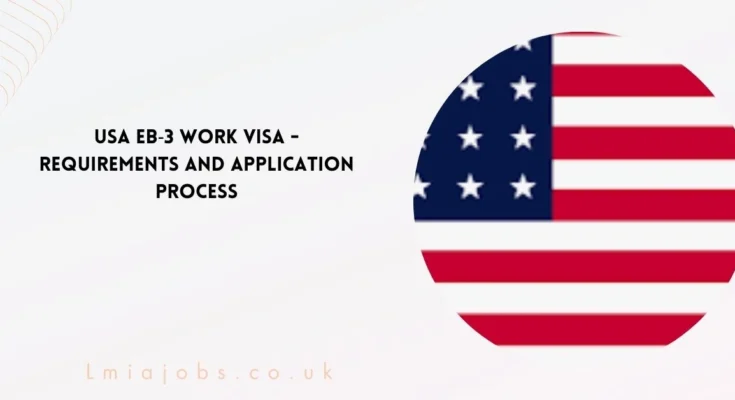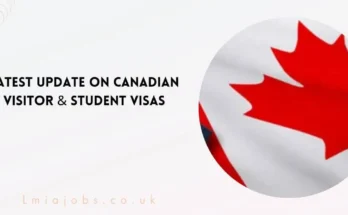The EB-3 visa provides a potent and long-lasting tool for foreigners to realize their American dream, especially since the need for both skilled and unskilled labor in the US keeps growing. The Foreign Labor Application Gateway (FLAG) system is one of numerous significant modifications and procedural changes that are influencing how employers and applicants handle the application process in 2025, even though the fundamental eligibility requirements are still the same.
Knowing who is eligible for the EB-3 visa, how it works, and where to look for job sponsorships is important whether you are a trained professional, an experienced worker, or someone seeking to fill necessary but less specialized positions. Everything you need to know to increase your chances of obtaining an EB-3 visa in 2025 is covered in this article.
What is the EB-3 Visa and who is it for?
A direct route to U.S. permanent residency (Green Card) is the EB-3 visa, which is an employment-based immigrant visa. The EB-3 category is intended for foreign nationals with employer sponsorship for full-time, permanent occupations in the United States, as opposed to temporary work visas (like H-1B or H-2B). Three subcategories comprise the program:
1. Skilled Workers
- requires a minimum of two years of job experience or training.
- The position must not be temporary or seasonal.
- The company must demonstrate that no suitable U.S. candidates are available for the job.
- Examples include mechanics, electricians, plumbers, welders, IT specialists, and cooks.
2. Professionals
- requires a bachelor’s degree from the United States or its equivalent in another country for a job where a degree is often needed.
- The degree must have a direct bearing on the position.
- For the post, the employer must demonstrate a labor shortage in the United States.
- Engineers, educators, accountants, architects, and software developers are a few examples.
3. Other (Unskilled) Workers
- for non-seasonal, permanent positions requiring fewer than two years of experience or training.
- For these positions, employers must demonstrate that they are unable to obtain local U.S. labor.
- Workers at factories, farms, hotels, cashiers, housekeepers, and cleaners are a few examples.
With these extensive subcategories, the EB-3 visa continues to be a practical and accessible option for workers in a wide range of sectors, including IT, engineering, construction, and hospitality.
New 2025 Applicable Changes for EB-3 Visa Program
- The FLAG System (Foreign Labor Application Gateway): Employers are now required to use the FLAG system, which was launched in June 2023, when filing labor certification applications (Form ETA-9089). Applications have been made more efficient by this electronic system, but additional procedural subtleties have also been added.
- Processing Backlogs & Priority Dates: Because of the tremendous demand, EB-3 applicants’ priority dates change every month. When an applicant can move forward with their visa application is determined by the USCIS Visa Bulletin.
- Faster Processing for Some Professions: Employer sponsorship approvals and labor certifications have been expedited for some industries that are experiencing a labor shortage, such as skilled trades and healthcare.
Who Can Apply for an EB-3 Visa in 2025?
Applicants must fulfill the following requirements in order to be eligible for an EB-3 visa:
- Skilled Workers: Two (02) years of training or experience is a minimum requirement.
- Professionals A bachelor’s degree or its equivalent in a related discipline is required for professionals.
- Unskilled Workers: Employers must be willing to offer a full-time, permanent position; no formal training is necessary.
3 Job Categories Qualify for EB-3 Visa in 2025
- Skilled Workers – Welders, electricians, IT technicians, cooks, and manufacturing workers.
- Professionals – Engineers, accountants, healthcare administrators, teachers, and financial analysts.
- Unskilled Workers – Housekeeping staff, janitors, farmworkers (non-seasonal), and food service staff.
| Visa Type | Type | Eligibility | Job Offer Required? | Labor Certification Needed? |
|---|---|---|---|---|
| EB-3 | Immigrant (Green Card) | Skilled, professional, and unskilled workers | ✅ Yes | ✅ Yes |
| H-1B | Nonimmigrant (Temporary) | Specialty occupations requiring a bachelor’s degree | ✅ Yes | ❌ No |
| H-2B | Nonimmigrant (Temporary) | Temporary, non-agricultural work | ✅ Yes | ✅ Yes |
| EB-1 | Immigrant (Green Card) | Extraordinary ability, researchers, and multinational executives | ❌ No (self-petition possible) | ❌ No |
| EB-2 | Immigrant (Green Card) | Advanced degrees or exceptional ability | ✅ Yes (unless National Interest Waiver – NIW) | ✅ Yes (unless NIW) |
Candidates can select the best course of action based on their qualifications and employment chances by being aware of these distinctions.
How to Apply for an EB-3 Visa: Step-by-Step Guide
Follow these four simple steps to successfully apply for your EB-3 visa and move to the United States in 2025.
Step 1: Secure a Permanent Job Offer & Labor Certification
Find a U.S. Employer willing to sponsor you for a full-time, permanent job.
Your employer must submit Form ETA-9089 (Permanent Labor Certification) through the DOL FLAG system.
The U.S. Department of Labor (DOL) must approve the labor certification before moving to the next step.
Step 2: Employer Files Form I-140 (Immigrant Petition for Alien Worker)
Once labor certification is approved, your employer files Form I-140 with U.S. Citizenship and Immigration Services (USCIS).
Your employer must prove that:
- The job is permanent and available.
- The employer has the financial ability to pay your wages.
Step 3: Wait for Visa Availability (Priority Date)
Your priority date is the date USCIS receives Form I-140.
Check the USCIS Visa Bulletin monthly to track your priority date.
You must wait until a visa is available before proceeding to the final step.
Step 4: Final Processing (Adjustment of Status OR Consular Processing)
If you are in the U.S.:
- File Form I-485 to adjust your status to permanent resident (Green Card holder).
If you are outside the U.S.:
- Apply for an immigrant visa through consular processing by submitting Form DS-260.
- Attend a visa interview at a U.S. embassy or consulate in your home country.
Once approved, you will receive your Green Card and can legally work in the U.S. as a permanent resident!
Conclusion
For skilled, professional, and unskilled individuals looking to obtain permanent residency in the United States, the EB-3 visa is still a feasible option. It is essential to keep up of application requirements due to procedural changes such as the FLAG system. Applicants can increase their prospects of receiving a Green Card and starting a new life in the United States by seeking employer sponsorship and adhering to the proper procedures.
Frequently Asked Questions
-
What is the EB-3 visa?
Under the three divisions of skilled workers, professionals, and unskilled workers, the EB-3 visa is an employment-based immigrant visa that allows foreign workers to obtain permanent residency (green card) in the United States.
-
Who qualifies for the EB-3 visa in 2025?
Skilled Workers: Requires at least two years of training or experience.
Professionals: Requires a U.S. bachelor’s degree or equivalent.
Unskilled Workers: Requires no formal training but must have a full-time, permanent job offer.

